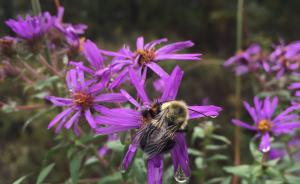As you enter the woods on the way to stop #2 you are walking through a dry, upland oak/ hickory/ dogwood woodland. Its dryness is a function of the topography – the surface features which are a legacy of glacial activity which shaped this land thousands of years ago – and drainage. The soil of Mount St. John is well drained as it lies on top of 100-200 feet of sand and rock, deposited here by the glaciers. The most recent of the four glaciers to cover parts of Ohio, the Wisconsinan which receded from this area about 17,500 years ago, left snakelike mounds of soil and rock called eskers. This portion of the woods is located on such an esker. The well-drained soil helps determine which plants can grow here. The oak and hickory trees thrive in thin, dry soil. They tend to have shallow root systems and are susceptible to being blown over in storms; thus, their average lifespan is only about 100 years. Notice the large oak a few feet down the trail on the left side – it is an exception. At about 150 years old, it is the oldest tree in the woods. It has even survived a lightening strike, as evidenced by the strip of burnt bark.
The disturbance created when mature trees are blown over is actually a natural part of the health of the woods. A disturbance changes a landscape and the environment. Consider what happens when a tree falls — new soil is exposed and sunlight hits the soil where leaves had previously cast shade. The seedlings of oaks and hickories grow slowly when they are young in the protective shade of adult trees, but their growth accelerates in the patches of sunlight that strike the woodland floor after a mature tree has fallen. This helps maintain a population of mature oak-hickory trees.
Of course, losing too many trees at once creates a larger disturbance that is much harder to overcome. When a forest is clear-cut so much soil is exposed is it susceptible to run-off, and nutrients are lost. Young trees lose shade in which to grow (if there is a remaining seed source in the area).





